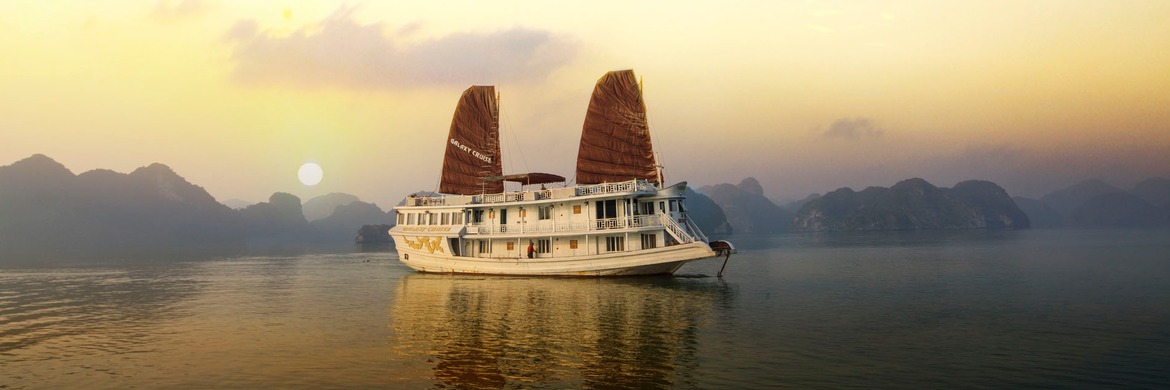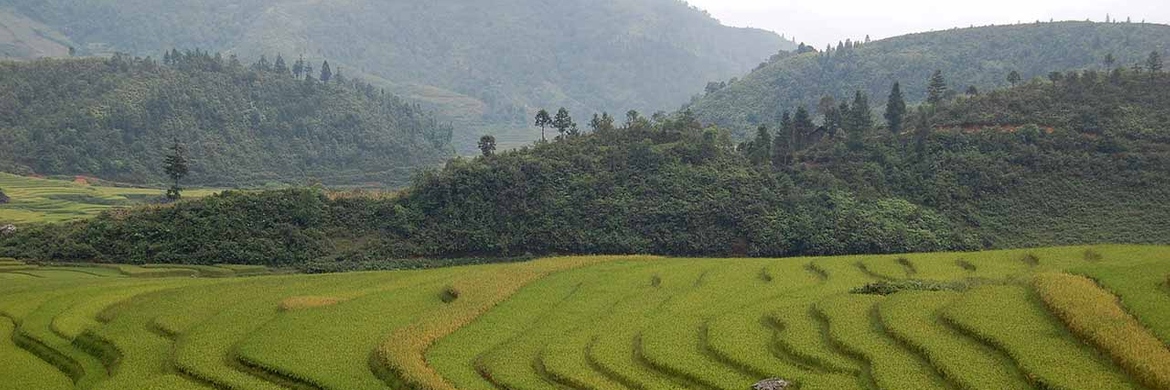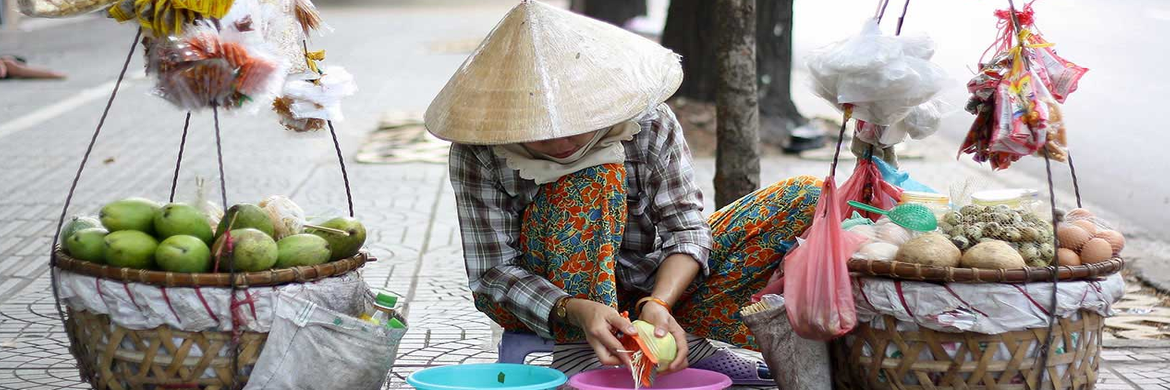Vietnam Escapes
Characterized by a long s-shaped geography running from wind-swept peaks in the northern frontier to languid chocolate-coloured waters of the southern Mekong Delta, Vietnam’s incredible diversity of offerings is a credit to its position along the Indochina Peninsula. Relative to its land area, it has one of the longest and most abundantly beautiful coastlines, facing both the Eastern Sea and the Gulf of Thailand.
Vietnam is a tropical land of outgoing people, bustling capitalist-oriented cities, heavenly beaches, brilliant green rice paddies and lush emerald rainforests. Like the rest of Indochina (including Laos and Cambodia), Vietnam is a former French colony and has been independent since 1954 – when the French Foreign Legion suffered a telling blow at Dien Bien Phu. Vietnam still retains a strong French cultural influence, with wide boulevards, magnificent Belle Époque architecture, fresh baguettes sold on every corner, good espresso and fine Bordeaux at open air cafes widely available.
The Vietnamese are much closer culturally to China, with Confucian ethics valuing age, education and hard work. The Vietnam War has long since been forgotten and the people are exceedingly warm and hospitable. The nation features temples, historic ports, a bevy of unspoilt tropical islands, museums, art, and over 50 hill tribes. From the big cities to the rice bowl of the south, Vietnam has it all.
Vietnam lends itself well to epics. Snaking sinuously down from the Chinese border to the Gulf of Thailand, its bounty of towering peaks, emerald green paddies, seemingly endless white sand beaches and deep roots in the past offer enough mystic allure to satiate the thirsts of any traveller.
SAIGON (HO CHI MINH CITY)
For over a hundred years, Saigon was the capital – first under the French colonizers, and later the regime of South Vietnam. Following the end of the Vietnam War, Saigon was renamed Ho Chi Minh City, though locals still refer to it by its old name. Today, Saigon is the industrial and commercial heart of the country, attracting green youth and seasoned businessmen alike with its rapid expansion and numerous opportunities. While development is rampant, the city still retains infrastructure from its days as the colonial capital – with quaint, European-style architecture alongside newly-constructed commercial buildings.
HANOI
Settled since prehistoric times, Hanoi has been an important city throughout Vietnamese history, serving as the capital of a number of Vietnamese dynasties. Following the end of the Vietnam War, Hanoi became the capital of the country. Today, Hanoi provides a rich blend of new and old Vietnam, from the thousands of young workers on scooters streaking down the wide Parisian-style boulevards, to the chic fusion restaurants housed in former colonial buildings. Even as the city buzzes with heavy development and modernization, it retains its idyllic charm. Enjoy Hanoi’s tranquil parks and lakes, peruse galleries filled with emerging Vietnamese artists and fashion designers, and sample the city’s amazing cuisine and bustling street life.
NHA TRANG
A lively coastal city, Nha Trang overlooks the aquamarine waters of the South China Sea. While the city today is a modern, pleasant town, the area itself was quiet and undeveloped until the arrival of the French – who immediately set about transforming it into a seaside resort. Even during the turmoil of the Vietnam War, Nha Trang was a popular vacation destination for soldiers on leave; this trend continues today with an influx of tourists and sightseers. While Nha Trang,s main beach is perhaps not as radiant as it once was, there are a number of sandy areas nearby that are still exceedingly beautiful, including the secluded, quiet Doc Let beach. Most visitors to the area frequent Nha Trang,s luxury resorts, the best of which is the Six Senses Ninh Van Bay, which features quiet, secluded villas with panoramic views of the nearby South China Sea. Additionally, another famous sight is the Po Nagar Towers, a series of monuments dating back to the Cham Empire, a Hindu civilization that once ruled much of southern Vietnam.
HALONG BAY
Approximately a three-hour drive east of Hanoi, Halong Bay is a breathtaking landscape of 1,969 densely clustered limestone islands, arches and pinnacles rising right out of the emerald waters. Designated a World Heritage Site by UNESCO for its surreal beauty, Halong Bay is one of Vietnam’s top destinations.
NINH BINH
Nestled in the northern corner of Vietnam, is Ninh Binh, a city in the province of the same name and a perfect base to some of the more remote – and naturally beautiful – areas of the country. The city itself is home to under 150,000 people, but with its close proximity to cliffs, caves, and cathedrals, it has become a hub for travelers looking to visit some up-and-coming hotspots. On a journey either north or south through Vietnam, Ninh Binh is the perfect stop to catch one’s breath and see some spectacular – and not overcrowded – sites. As it has grown as a tourist destination, Ninh Binh has become very accessible on both bus and train routes, making it an easy stop for a couple days – with just the right number of things to do.
HOI AN & DANANG
From the 1600s to the 1800s, Hoi An was a major trading outpost known as Faifo. However, when the river silted up and the harbor became too shallow, trade moved north to Da Nang – and Hoi An lost its significance. Today, this cosmopolitan heritage is reflected in its mix of Japanese, Chinese, and Vietnamese influences. Because of its rich blend of aesthetics, the entire old city is a UNESCO World Heritage Site.
DALAT
The capital of Lam Dong province, Dalat is located in Vietnam’s south-central highlands, just under 200 miles from Ho Chi Minh city. Pleasantly sized, it’s as easy to get around as it is on the eye. Remnants of the French colonization remain; favoring the city’s cooler climates, the French built their holiday chalets and villas here, giving Dalat a charming alpine feel that is only emphasized by the pine forests at its edges. Known as “Petit Paris”, it’s less frenetic than its namesake; the friendly and welcoming urban center has a calm, slow pace and soon gives way to the lakes and rolling green hills with which it is surrounded, a backdrop of misty mountains in the background. Visitors to Dalat – glad of the respite from the rest of the country’s heat – will enjoy its pretty streets, quaint shops and excellent food, spanning the gamut from European to Asian. Activities and day trip options are many and varied, from a round of golf on a royal course, to an afternoon boating on the lake, or exploring the city’s architectural wonders, there’s something to suit all tastes.
HUE
For over a hundred years, the city of Hue was home to the capital of Vietnam under the emperors of the Nguyen Dynasty. Because of this legacy, Hue brims with a wealth of cultural and historic treasures, from imperial tombs to the ruined palaces of the Forbidden Purple City, where only the emperors, concubines and members of their households were permitted – and where trespassers were put to death.
- Explore stunning landscapes – Admire the impressive limestone karsts of Ninh Binh and Halong Bay, then cruise through the Mekong Delta’s lush waterways.
- Get a local perspective of Vietnam – Venture through Ho Chi Minh City’s maze of laneways and dine at Hanoi’s best street stalls with insightful local guides.
- Indulge in Vietnam’s best – Stay at atmospheric luxury hotels, dine at top tables, meet friendly locals and discover incredible traditional handicrafts and art.
- Swim in the clear waters of Nha Trang- Cruise along the islands around Nha Trang and get a chance to swim among tropical fish and colourful corals
- Get a mud bath – Dip into a mud bath in the countryside which is known to provide several health benefits
- Explore the countryside by boat- View the quiet countryside via a boat ride, pass by fleets of boats and meet with local families
- Trek through the Green Hmong hill tribe in Xa Linh – Take a 2 to 4-hour hike to Xa Linh and get a chance to meet the hill tribe community of Green Hmong
- Witness a traditional Vietnamese performance – Learn about the Vietnamese ethnic group’s history and way of living through music and dance
- Visit Ho Chi Minh’s house- View the stilt house of the very first President of Vietnam, Ho Chi Minh
- Witness a cultural performance – Watch the ‘My Village’ show which highlights Vietnam’s village traditions and celebrations
- Cruise along Halong Bay – Enjoy a slow boat ride through the emerald waters of Halong Bay
- A glimpse into local daily life – Learn how Hanoi locals go about their day by visiting the busy market of Long Bien and the vibrant Hoan Kiem Lake
- Visit an ancient village – Go to Duong Lam and appreciate the ancient architecture made of laterite and mud
- Learn how to cook Vietnamese cuisine – Learn from a top masterchef on how to prepare sumptuous Vietnamese dishes
- Water Puppetry in Dao Thuc Village – Watch how traditional puppet masters perform this mesmerising ancient art form in chest-deep waters in charming Dao Thuc Village.
- Fun and engaging cultural experiences – Join in a traditional morning Yijinjing exercise, get hands-on making personal ceramic products at a social enterprise and go on a smartphone treasure hunt to discover the city of Saigon
- Perfect blend of activities and leisure – Enjoy a perfect pace of activities and leisure such as exploring famous Cu Chi Tunnels and relaxing on pristine white sand beaches of Phu Quoc.
- Cu Chi Tunnels – Discover the famed Cu Chi tunnels, an interconnecting network of subterranean passageways under Saigon used during the Vietnam War to evade the American military and stage campaigns such as the infamous Tet Offensive.
- Private Junk Cruise – Embark on your private junk, a traditional wooden boat that has been luxuriously fitted with traditional Chinese rosewood furniture and design elements in each of the two bedrooms. Cruise through the islands and explore their quirks and characteristics – some of the islands are hollow, hiding caves and grottoes, and support floating villages of fishermen, who ply the shallow waters.
- Visit to Cham Islands – Take a private boat to the nearby Cham Islands. These islands are a quiet little fishing area populated by ethnic Cham people, an Austro-Asiatic group that fought the north Vietnamese for this territory for centuries. The islands are famed for salanganes, swallows whose nests have long been considered a delicacy by aristocrats and the wealthy. The islands are also a fine place to go snorkeling, as its waters are filled with all the manner of coral reefs and dazzling tropical fish.
- Cycling Tours- Explore the notable buildings of Hoi An on two wheels. Notable sites include the Japanese Covered Bridge, the Old House of Phung Hung, and the Sa Huynh Culture Museum.




